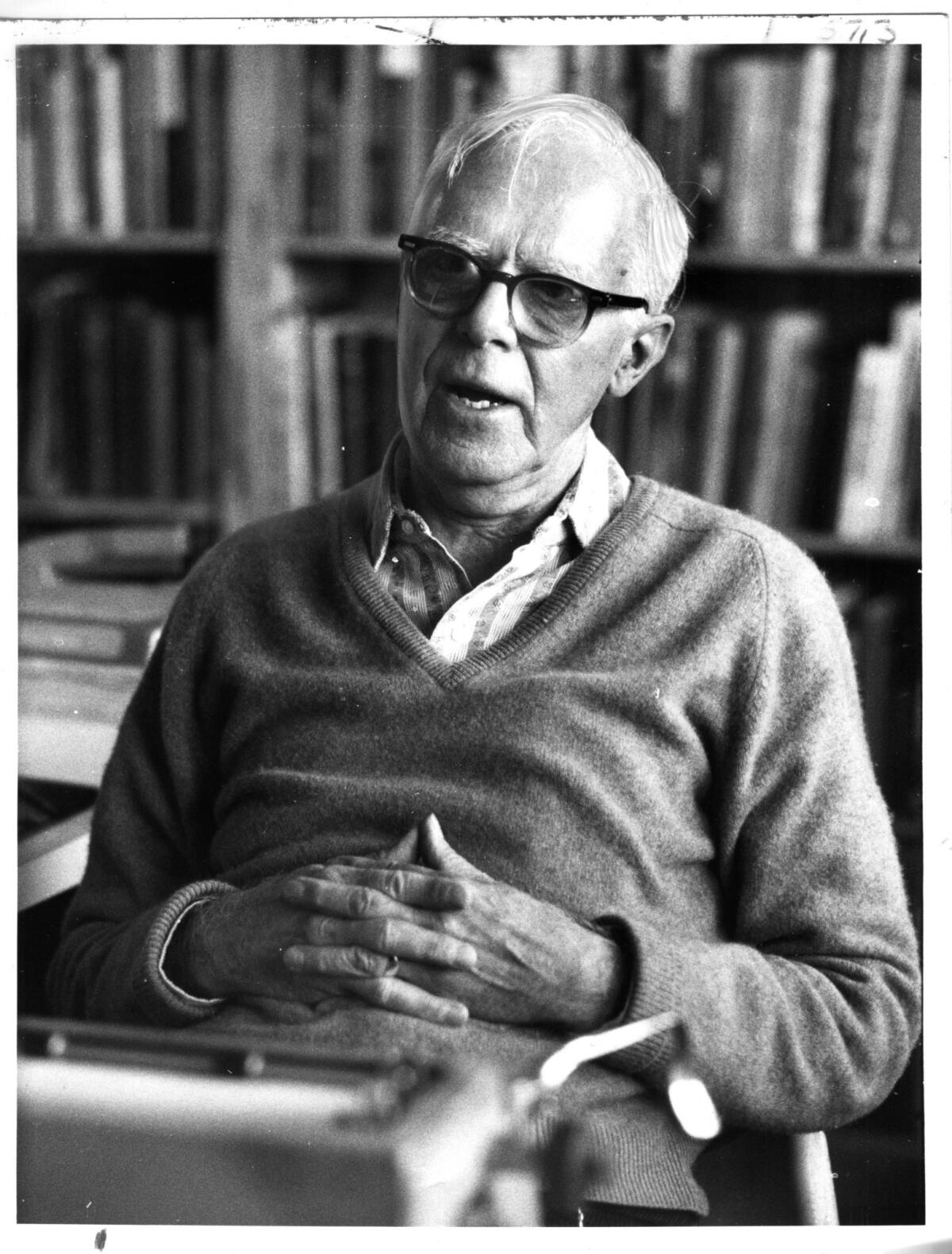Martin Gardner dies at 95; prolific mathematics columnist for Scientific American

- Share via
Martin Gardner, for 25 years the master of matters mathematical for Scientific American’s “Mathematical Games” column and later the punisher of the paranormal and the pseudoscientific in his column “Notes of a Fringe Watcher” for the Skeptical Inquirer, died Saturday at a hospital in Norman, Okla. He was 95. No cause of death was announced.
A prolific, insightful, concise and clear writer, Gardner was the author of more than 70 books about mathematical puzzles, pseudoscience, philosophy, and the arcana of “Alice and Wonderland,” G.K. Chesterton and other popular works and authors.
Though Gardner was not a mathematician himself, his lucid explanation of puzzles and other mathematical phenomena seduced a generation of youngsters into the field.
“When I was 14 years old, at the height of the Vietnam War, I picked up a copy of Scientific American,” Dennis Shasha of New York University’s Courant Institute of Mathematical Sciences wrote in a tribute on Scientific American’s website. For the most part, the articles were impenetrable, he said. “Then I got to Martin’s column. A whole new world opened for me.”
“This is really a sad day… because he had such a profound influence on so many of us,” Gardner’s friend Douglas Hofstadter, the Pulitzer Prize-winning author of “Godel, Escher, Bach: An Eternal Golden Braid” who succeeded Gardner at Scientific American, wrote on the magazine’s website. “He is totally unreproducible — he was sui generis — and what’s so strange is that so few people today are really aware of what a giant he was in so many fields.”
Those included “the propagation of truly deep and beautiful mathematical ideas (not just ‘mathematical games,’ far from it!); the intense battling of pseudoscience and related ideas; the invention of superb magic tricks; the love for beautiful poetry; the fascination with profound philosophical ideas; the elusive border between nonsense and sense … and on and on and on and on,” Hofstadter said.
In a glowing, 1999 book review in the New York Times, critic Adam Gopnik noted that “Gardner has an old-fashioned, almost 19th-century, Oliver Wendell Holmes kind of American mind — self-educated, opinionated, cranky and utterly unafraid of embarrassment.”
Martin Gardner was born Oct. 21, 1914, in Tulsa, Okla., where he spent most of his time on chess, magic tricks, science, mechanical puzzles and L. Frank Baum’s Oz series. He majored in philosophy at the University of Chicago, graduating in 1936.
Returning to Oklahoma, he got a job as assistant oil editor at the Tulsa Tribune. Quickly bored, he returned to Chicago, where he worked in the university’s press office and moonlighted selling magic tricks.
During World War II, he spent four years as a yeoman on a Navy destroyer, filling his night watches by writing short stories, including “The Horse on the Escalator,” about a man who collected horse jokes. He sold it to Esquire.
After the war, he was a freelance writer for Esquire until the magazine got a new editor who didn’t appreciate his quirky style. To support himself, Gardner took a job as an editor at the children’s magazine Humpty Dumpty, where he wrote regular stories and a monthly “poem of moral uplift.”
He wrote his first book during this period, “Fads and Fallacies in the Name of Science,” which took aim at fraud and quackery in science. Gardner had difficulty finding a publisher because few thought there would be much interest in it, but the book is still in print.
In 1956, he wrote a freelance story for Scientific American about hexaflexagons, strips of paper that mathematicians folded into complex shapes. Impressed, the publisher offered him a job as a monthly columnist on mathematics.
The problem, he later said, was that he knew very little about mathematics. “Beyond calculus, I am lost. That was the secret of my column’s success. It took me so long to understand what I was writing about that I knew how to write in a way most readers would understand.” Gardner scoured book stores in New York, looking for rare books containing the puzzles and other materials that became the lifeblood of his column.
In 1976, Gardner, Carl Sagan, Isaac Asimov and others formed the Committee for the Scientific Investigation of the Paranormal to debunk false science. The group, now known as the Committee for Skeptical Inquiry, publishes a journal, the Skeptical Inquirer, for which Gardner wrote a monthly column until 2002.
In later years, Gardner compiled a series of annotated works, including the “Alice in Wonderland” stories, in which the wide margins of the books were filled with carefully researched information about obscure references in the stories, philosophical underpinnings and other interesting facts. His research showed, for example, that the “golden afternoon” on which “Alice in Wonderland” occurred was actually cool and damp.
Gardner’s many admirers have gathered every two years since 1993 for a conference called Gathering for Gardner or G4G, which features presentations and new tricks and puzzles by magicians, mathematicians and others.
Gardner’s wife of 48 years, the former Charlotte Greenwald, died in 2000. He is survived by two sons, James of Norman and Tom of Asheville, N.C.; and three grandchildren.
More to Read
Start your day right
Sign up for Essential California for the L.A. Times biggest news, features and recommendations in your inbox six days a week.
You may occasionally receive promotional content from the Los Angeles Times.



